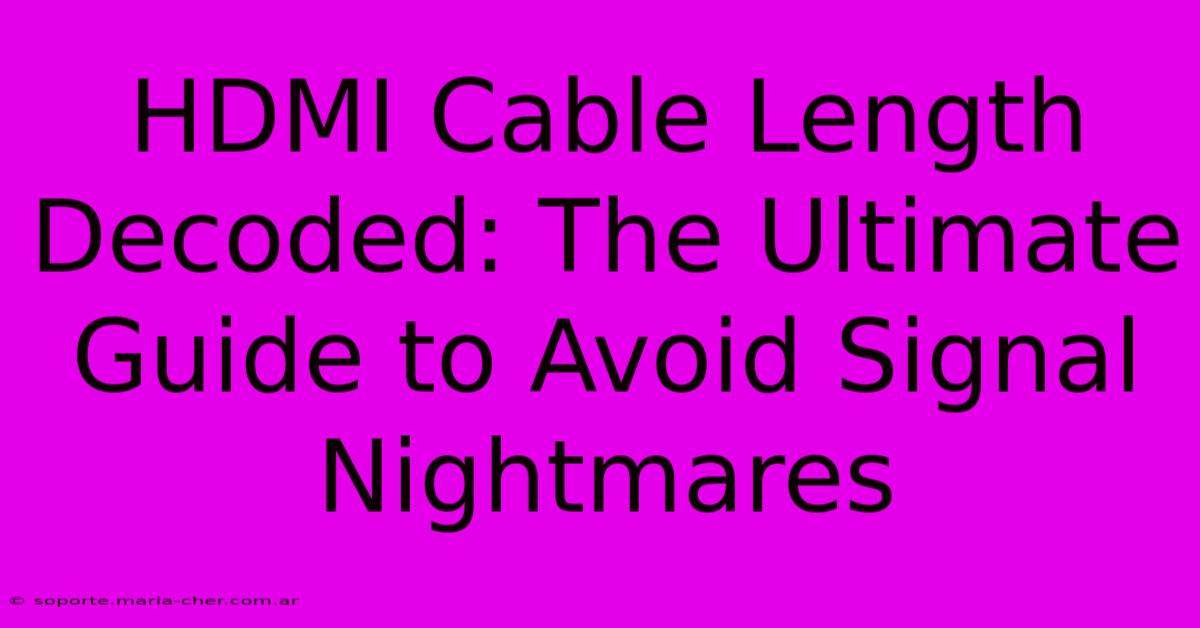HDMI Cable Length Decoded: The Ultimate Guide To Avoid Signal Nightmares

Table of Contents
HDMI Cable Length Decoded: The Ultimate Guide to Avoid Signal Nightmares
Choosing the right HDMI cable might seem simple, but the length plays a surprisingly crucial role in picture and sound quality. A poorly chosen cable length can lead to frustrating signal issues, from pixelation and flickering to complete signal loss. This ultimate guide will decode the mysteries of HDMI cable length, helping you avoid those dreaded signal nightmares and achieve the best possible audio-visual experience.
Understanding HDMI and Signal Degradation
HDMI (High-Definition Multimedia Interface) transmits both audio and video data digitally. While digital signals seem like they should be immune to degradation, the reality is slightly more nuanced. Longer cables introduce the potential for signal attenuation – a weakening of the signal strength. This attenuation manifests in several ways:
- Pixelation and Flickering: A weak signal can cause images to become pixelated, with noticeable blockiness or shimmering artifacts.
- Color Degradation: Colors may appear washed out or inaccurate.
- Audio Dropouts: Sound may cut out intermittently or become distorted.
- Complete Signal Loss: In severe cases, the signal might fail entirely, resulting in a black screen.
HDMI Cable Length and Signal Quality: The Relationship
The relationship between cable length and signal quality isn't linear. Shorter cables generally perform better, with signal loss being minimal. However, the maximum reliable length varies depending on several factors:
- HDMI Version: Newer HDMI versions (e.g., HDMI 2.1) often offer improved signal integrity over longer distances compared to older versions (e.g., HDMI 1.4).
- Cable Quality: Higher-quality cables, using thicker gauge wires and better shielding, are less susceptible to signal loss. Cheap cables are more prone to problems at shorter lengths.
- Resolution and Refresh Rate: Higher resolutions (like 4K or 8K) and higher refresh rates (like 120Hz) demand more bandwidth, increasing the likelihood of signal degradation with longer cables.
- Cable Construction: The internal construction, including the type of conductors and shielding, significantly impacts signal integrity.
How Long is Too Long? A Practical Guide
There's no magic number for the maximum HDMI cable length. However, here's a general guideline:
- Standard HDMI (1.4 and earlier): For optimal performance with 1080p, aim for lengths under 25 feet (7.6m). Beyond that, signal problems become more likely.
- High-Speed HDMI (2.0 and 2.1): These versions offer better performance over longer distances. You might get away with 30-50 feet (9-15m) with high-quality cables and proper shielding. However, exceeding these lengths increases the risk of issues. For 4K@120Hz or 8K signals, even shorter lengths are recommended.
Important Note: These are estimations. Signal loss depends heavily on the quality of the cable and the specifics of your setup.
Tips for Avoiding HDMI Signal Problems
- Prioritize Cable Quality: Invest in a high-quality, certified HDMI cable from a reputable brand. Don't skimp on this; a cheap cable is more likely to be the source of your signal woes. Look for cables explicitly stating support for your resolution and refresh rate.
- Consider Active HDMI Cables or Extenders: For distances beyond the recommended lengths, consider using active HDMI cables or extenders. These actively amplify the signal, improving performance over long runs.
- Proper Cable Management: Avoid sharp bends or kinks in the cable, which can compromise signal integrity. Keep cables neatly organized to prevent damage.
- Check Your Connections: Ensure both ends of the cable are securely connected to your devices.
Troubleshooting Common HDMI Issues
If you're experiencing signal problems, try these troubleshooting steps:
- Try a shorter cable: The quickest way to determine if cable length is the culprit.
- Replace the cable: A faulty cable is a common source of HDMI problems.
- Check for interference: Other electronic devices may interfere with the HDMI signal. Try relocating the cable or devices.
- Check device settings: Ensure your source and display devices are properly configured for the desired resolution and refresh rate.
Choosing the correct HDMI cable length is crucial for a seamless viewing and listening experience. By understanding the factors that affect signal quality and following these tips, you can avoid HDMI headaches and enjoy your entertainment without interruption. Remember, investing in a high-quality cable appropriate for your setup is always worthwhile in the long run.

Thank you for visiting our website wich cover about HDMI Cable Length Decoded: The Ultimate Guide To Avoid Signal Nightmares. We hope the information provided has been useful to you. Feel free to contact us if you have any questions or need further assistance. See you next time and dont miss to bookmark.
Featured Posts
-
Elevate Your Photography Experience The Unparalleled Leica D Lux 6
Feb 09, 2025
-
Say Happy Holidays In Style Create Custom Business Cards That Shine
Feb 09, 2025
-
Your Guide To Fotolia Discover The Ultimate Source For Royalty Free Visual Content
Feb 09, 2025
-
Liver Panel Cost Unlocking The Secrets To Liver Health
Feb 09, 2025
-
Blazing Trails Meet The Players Who Defied Time On The Basepaths
Feb 09, 2025
